By Amanda Wilks
Virtually every mountain biker wants to be like the pros. Whether you've been competing for years or just got out on the trail for the first time, chances are good that you're always looking for ways to improve.
And while everybody's style and process toward improvement is different, sometimes it is helpful to hear what the world's best MTB racers do to stay in top form.
Below are five training tips you can start using today.
1. Pick Up Some Weights
It may seem strange that the first tip on the list is not directly related to biking. But Rachel Atherton of Atherton Racing Team explains that carefully-planned gym time will make a difference in your riding ability.
She suggests performing the deadlift, a compound lift that engages your entire body. In particular, the deadlift engages your back, glutes, core, and hamstrings, and strengthening all of these muscle groups will improve your power and endurance on the bike.
As with any exercise, proper form on the deadlift is paramount if you want to avoid injury. Watching demonstrations online and talking to an experienced trainer can help you get started safely if you are unfamiliar with the lift. 
2. Challenge Yourself When It Comes to Tracks
Gee Atherton explains that, if you want to progress, it's extremely important that you don't go easy on yourself. Specifically, he suggests building or seeking out new sections of track to work on your weak points. After all, if you ride the same track over and over again, you won't progress in terms of the skills you need to improve.
Mountain biking is like any other skill - you need to push yourself and address your weaknesses head-on. If steep descents feel like your nemesis, it's certainly tempting to just avoid them. But if you confront that feeling and ride them until you're comfortable, you will develop as a racer and broaden your skill set considerably.
3. Mental Perseverance is Key
Many training tips for MTB riders focus on the physical, but for top racer Jack Moir, having the mental fortitude to get through multiple injuries is one of the main reasons he's still competing.
Before he made the podium at the World Cup, Moir broke his collarbone while training. The injury became infected and required multiple surgeries. He ultimately had to spend two years on the sidelines of the sport, and at one point, he thought he couldn't race anymore. Because he persevered, Moir is now one of the world's best riders.
This mental fortitude has also helped many riders, even those outside of the MTB discipline, deal with chronic health issues. CycleOps Brand Ambassador Jill Kuhn works around rheumatoid arthritis, osteoporosis, hypothyroidism, and asthma while training for Ironman races. Kuhn says that when she felt as though her body faltered, her mental and spiritual strength grew. 
4. Film Yourself Training
Rachel Atherton believes that there's no substitute for filming yourself while training. When you watch yourself navigate a switchback or ride over roots, you can quickly determine what you can do to improve. She stresses the importance of scrutinizing every aspect of your ride, since this may even show you a few things that are easy fixes.
The same goes for racing - if you can have someone record you at key points in the race, you will be able to see where your form or your skills start to break down under pressure, and then work to correct that while you're training. If you're like a lot of people, watching yourself on the bike might seem awkward at first, but overcoming that awkwardness is well worth it, since seeing yourself ride is often a fast track to improvement.
5. Sometimes, Taking Difficult Sections of Track Slowly is Worth It
Jack Moir says that the Fort William track is "heaps of fun" to ride, but it does have one difficult section - the woods. In navigating this section, Moir says that taking it somewhat slowly may be an acceptable tradeoff. He explains that crashing often means losing the race, so losing a little time riding over a tough section of roots can be worthwhile.
At Fort William, Moir tried attacking the woods but felt it negatively affected the ride, so he opted instead to pin the course on either side of the woods and then took the woods a bit more slowly.
This piece of advice also underscores why it's so important to be familiar with a course before you race it - a walkthrough and a ridethrough or two will help racers identify problem areas of the track so they can better plan what areas may need more caution than others. 
While not all of these training tips will resonate with every rider, hearing how professional mountain bike racers deal with challenges, cross-train, and plan their races may be helpful in finding what specific strategies work for you.
Give one (or more) of these tips a try the next time you're out on the trail, walking through a track, or planning out a cross-training session.
And if you’re coming off an trail-induced injury like Wil of Singletrack Magazine, consider keeping your legs shred-ready with the help of an indoor trainer.
About Amanda:
Amanda Wilks is a professional writer and a MountainBikeReviewed contributing author. She has always been fascinated with sports and as a passionate MBT rider, she never misses a trail. See more of Amanda’s writing on Twitter.
